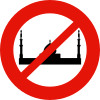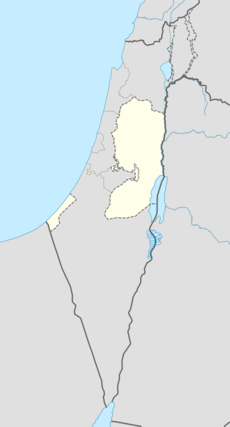
Back مذبحة الحرم الإبراهيمي Arabic হেবরন মসজিদ হত্যাকাণ্ড Bengali/Bangla Massacre de la Cova dels Patriarques Catalan Masakr v Jeskyni patriarchů Czech Baruch Goldstein#Massaker in der Grotte der Patriarchen German Masacre de Hebrón de 1994 Spanish قتلعام مسجد الخلیل Persian Patriarkkojen haudan joukkomurha Finnish Massacre d'Hébron (1994) French Sléacht Mhosc Ibrahimi (1994) Irish
| Cave of the Patriarchs massacre | |
|---|---|
| Part of Israeli settler violence | |
 The compound in 2009 | |
Location of Hebron within the West Bank Location of Hebron within the de jure State of Palestine | |
| Location | Hebron, West Bank |
| Date | February 25, 1994 |
| Target | Muslim worshippers |
Attack type | Zionist terrorism, mass murder, mass shooting |
| Weapons | IMI Galil |
| Deaths | 30 (including the perpetrator) |
| Injured | 125 |
| Perpetrator | Baruch Goldstein |
| Motive | Anti-Palestinian racism, Jewish extremism |
| Part of a series on |
| Islamophobia |
|---|
 |
The Cave of the Patriarchs massacre, also known as the Ibrahimi Mosque massacre or the Hebron massacre,[1] was a shooting massacre carried out by Baruch Goldstein, an American-Israeli physician and extremist of the far-right ultra-Zionist Kach movement. On 25 February 1994, during the Jewish holiday of Purim, which had overlapped in that year with the Islamic holy month of Ramadan,[2] Goldstein opened fire with an assault rifle on a large gathering of Palestinian Muslims praying in the Ibrahimi Mosque in Hebron. He killed 29 people, several as young as 12 years, and wounded 125.[3] Goldstein was overpowered and beaten to death by survivors.
The atrocity strained the Israeli-Palestinian Oslo Accords peace process, immediately setting off mass protests by Palestinians throughout the West Bank. During the ensuing clashes, a further 20 to 26 Palestinians were killed while 120 were injured in confrontations with the Israeli military,[4] and 9 Israeli Jews were also killed.[5]
Goldstein was widely denounced in Israel and by communities in the Jewish diaspora,[6] with many attributing his act to insanity.[7] Israeli prime minister Yitzhak Rabin condemned the attack, describing Goldstein as a "degenerate murderer" and "a shame on Zionism and an embarrassment to Judaism".[8][9][10] Some Jewish settlers in Hebron lauded him as a hero, viewing his attack as a pre-emptive strike and his subsequent death as an act of martyrdom.[11] Following statements in support of Goldstein's actions, the Jewish ultranationalist Kach party was banned and designated a terrorist organization by the Israeli government.[12]
- ^ Yoram Peri, The Assassination of Yitzhak Rabin, Stanford University Press, 2000, pp. 100–103: "The Hebron massacre in perspective".
- ^ George J. Church,"When Fury Rules", Time 7 March 1994 (subscription required)
- ^ Issacharoff, Avi; Levinson, Chaim (28 February 2010). "Settlers Remember Gunman Goldstein; Hebron Riots Continue". Haaretz. Archived from the original on 6 January 2014. Retrieved 25 February 2024.
- ^ Ami Pedahzur, Arie Perliger Jewish Terrorism in Israel (Archived 3 January 2017 at the Wayback Machine). Columbia University Press, 2011. p. 70.
- ^ Paul G. Pierpaolo, Jr, "Hebron Mosque Massacre", in Spencer C. Tucker, Priscilla Roberts (eds.), The Encyclopedia of the Arab-Israeli Conflict: A Political, Social, and Military History (Archived 3 January 2017 at the Wayback Machine). ABC-CLIO, 2008. p. 438.
- ^ Norman Solomon, 'The Ethics of War in Judaism,' in Torkel Brekke (ed.), The ethics of war in Asian civilizations: a comparative perspective Archived 3 January 2017 at the Wayback Machine Routledge, 2006, pp39-78 p.44
- ^ 1 Wilson, Rodney. 2007. Review Article: Islam and Terrorism. British Journal of Middle Eastern Studies. 34(2):203–213. {{Doi:10.1080/13530190701427933}}. Accessed 29 August 2010).
- ^ Haberman, Clyde (1 March 1994). "West Bank Massacre: The Overview; Rabin Urges the Palestinians To Put Aside Anger and Talk". The New York Times. Archived from the original on 21 February 2012. Retrieved 28 April 2010.
- ^ Alan Cowell (2 March 1994). "West Bank Massacre; In 'Tragic Error,' Soldiers Kill a Settler". The New York Times. Archived from the original on 28 July 2018. Retrieved 27 July 2018.
- ^ Youssef M. Ibrahim (6 March 1994). "The World; Palestinians See a People's Hatred in a Killer's Deed". The New York Times. Archived from the original on 25 July 2018. Retrieved 27 July 2018.
- ^ Sarah Helm (28 February 1994). "Hebron settlers shed no tears after slaughter: Militant Jews are turning mass killer Baruch Goldstein into a folk hero, writes Sarah Helm from Kiryat Arba". The Independent. Archived from the original on 25 September 2015. Retrieved 25 August 2017.
- ^ In the Spotlight: Kach and Kahane Chai Center for Defense Information, 1 October 2002 Archived 22 November 2006 at the Wayback Machine
© MMXXIII Rich X Search. We shall prevail. All rights reserved. Rich X Search

